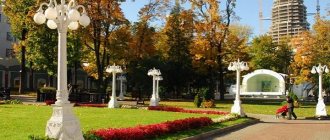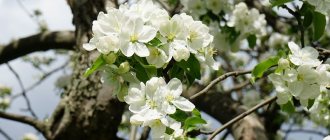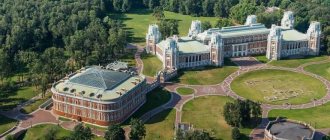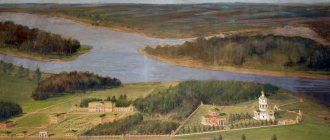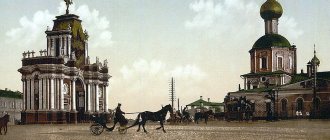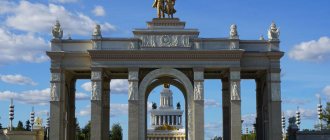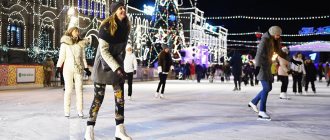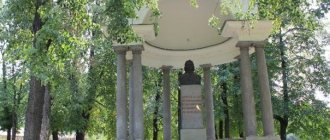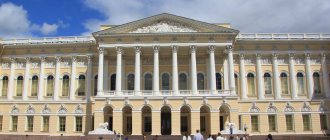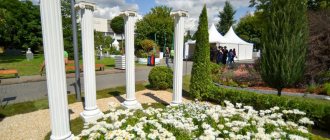Moscow has many entertainment and cultural institutions, one of them - the Hermitage Garden - is a whole complex with three theaters, a summer cinema and stage, cafes and various creative studios.
A rich cultural program attracts a large number of visitors to the Hermitage Garden. Some events have become traditional, for example, the International Festival “Jazz in the Hermitage Garden”, which has been held since 1998. The festival provides an opportunity to listen to jazz musicians in the open air for free.
© Official website of the garden
For the last few years, the family charity festival GALAFEST has been held in the Hermitage Garden in Moscow. In addition, the garden's program includes events on public holidays, international cultural festivals and other events.
Poster of events and news of the Hermitage Garden for March 2021
Landscape rarity "Hermitage" in Moscow - the history of the legend
The Hermitage Garden occupies a special place in the life of Muscovites; it has a special magnetism.
For more than 120 years, it has been the creative core and center of the city’s cultural life. Not only local residents love to spend time here, but also guests of the capital who strive to see the legendary Shchukin stage, which has seen stars of the first magnitude. “And they remember that the boards on these stages are imbued with their immortal spirit.”
The park was founded thanks to the enthusiasm and funds of the philanthropist-entrepreneur Ya. V. Shchukin. The famous merchant was an ardent supporter of creativity, he loved to organize all kinds of performances and mass celebrations. Here, on warm summer evenings, the mystery of performing arts took place. The entire capital's public sought to attend the famous Shchukin evenings.
Today it is difficult to imagine that the blooming, fragrant garden with shady alleys was originally a city dump. Yakov Vasilyevich Shchukin made incredible efforts to turn a dull, abandoned wasteland into a luxurious oasis.
During the construction process, about a meter of soil was removed from the territory of the future garden, and fertile black soil was laid in its place. Only after this were trees planted, walking paths paved, flower beds decorated, and the theater building reconstructed.
The triumph of the efforts was the grand opening of the Hermitage Garden on June 18, 1895.
Children's playground and other farewell photos
The Hermitage garden has not left the attention and care of its youngest visitors; they have their own territory. The children's playground here is quite spacious and equipped with a variety of devices for children's games and entertainment. Both vigilant parents and tired children relax on garden benches placed in the shade of trees along the perimeter of the children's playground, the size of which the Hermitage Garden surpasses many other parks.
The Hermitage Garden met the 2021 season without the inhabitants of the pheasant enclosure; the feathered inhabitants moved. The Moscow Zoo has provided the birds with more comfortable conditions, and competent staff will provide proper care. The Hermitage Garden, by eliminating non-core sections, has increased the children's area; there are other insufficiently developed areas here. Comfortable sun loungers await your visitors, and there are even tables nearby.
Along the walking paths there are electric lamps, noticeable from a distance, made according to ancient images. Some details from old lanterns, with relief monograms of the BOX, have been preserved and built into the new products. Moscow's first electrified park is trying to maintain the favorable recreational atmosphere for which it has been famous for more than a century.
The unique atmosphere of the theater square especially attracts lovers of performing arts to the Hermitage Garden.
It has been preserved here unchanged since the time of the founder, Yakov Vasilyevich Shchukin, for the second century. His personality definitely deserves to be immortalized in the created center of culture, but so far there is only talk about a monument. I would like to hope that the current generation of visitors will be able to see the long-awaited monument here. Tags: Moscow holidays with children Russia garden
This is what the Hermitage Garden looks like today
The owner, a popular entrepreneur, was actively involved in attracting creative groups, circus troupes, vocal performers and musicians. The official opening hours of the Hermitage Garden were from 6 p.m. until late evening. Music played in the park, artists of various genres performed, and the capital's public gathered.
The famous Shchukin stage has been added to the list of Russian cultural heritage. Since its founding, the theater has become not only a place for the debut of emerging artists, but also a platform for performances by famous people.
The tragic events of 1917 led Shchukin to ruin and loss of property. The garden was given the status of a national treasure, but during the NEP period the territory became private property.
Despite all the disasters, Hermitage Park has always remained a favorite vacation spot for the townspeople. People came here to play chess, read a book in solitude, and watch a movie in the summer cinema. All kinds of competitions and quizzes were organized for children, and festive concerts were held. The Hermitage garden plan is designed in such a way as to best meet the needs of vacationers.
Hermitage Garden
As a matter of fact, the Hermitage Garden was not always the way we are used to seeing it. It was even located in a different place: from 1830 until almost the end of the 19th century, it was located on Bozhedomka and was the first pleasure garden in Moscow, with gazebos, flower beds, a theater, a stage, coffee houses and pavilions. It reached its greatest prosperity in the era when it belonged to the famous entrepreneur, former actor of the Maly Theater M. V. Lentovsky. K. S. Stanislavsky recalled the Hermitage Garden of that time: “What was there in this garden: boating on the pond and water fireworks of incredible richness and diversity with the battle of armadillos and their sinking, tightrope walking across the pond, water festivals with gondolas, illuminated boats, bathing nymphs in the pond, ballet on the shore and in the water. Processions of a military orchestra, choirs of gypsies, Russian songwriters. All of Moscow and foreigners visiting it visited the famous garden.”
However, Lentovsky went bankrupt, and the garden fell into disrepair, and later it was completely built up with houses, and nothing any longer reminded of the times when all this bygone splendor was located on the site of Samotechny Lanes.
And so begins the history of the Hermitage garden in Karetny Ryad, born on the site of the former estate of merchant V.I. Olontsova. After several attempts to form a theater and garden here, undertaken by the Moscow Artistic Circle, merchant M.A. Lipsky, mechanical engineer K.V. Moshnin, the entire site came into the possession of the Moscow merchant Ya.V. Shchukin on July 16, 1894. This date is celebrated as the birthday of the Hermitage Garden.
In just a year, a boring wasteland turned into a blooming garden, flower beds and paths were laid out, trees and shrubs were planted, the theater building was reconstructed, and on June 18, 1895, the Hermitage officially opened. The Moscow public showed considerable interest in him - Shchukin’s tenacity and enthusiasm aroused involuntary respect even from those who reproached him for his lack of subtlety of taste.
In the same year, electric lighting appeared in the Hermitage, running water was installed, and a swimming pool was installed. A year later, one of the first film shows in Russia took place here. F. I. Shalyapin, A. V. Sobinov, A. V. Nezhdanova, S. V. sang on the stage of the Hermitage. Rachmaninov made his debut as a conductor, Sarah Brenard, Maria Ermolova, Vera Komissarzhevskaya played. In 1898, the Moscow Art Theater opened in the building of the Hermitage Theater, the first performance was “Tsar Fyodor Ioannovich,” and it was here that the premieres of Chekhov’s plays took place. L.N. Tolstoy and V.I. Lenin visited the garden.
Shchukin constantly undertook the construction of new theater venues; in 1909, the summer “Mirror” theater was built, he planned to open a unique winter theater with 4 thousand seats, but this plan was only partially destined to take place: the box, now called the Shchukin stage, is all that managed to build. Unfavorable circumstances generated by the First World War and the revolution led Shchukin to ruin.
After the revolution, the garden was first nationalized, then, during the NEP period, it was transferred to private rent. In 1924, the building of the Hermitage Theater housed the MGSPS (Moscow City Council of Trade Unions) theater, then it was renamed the Mossovet Theater, Yu. A. Zavadsky was appointed chief director. The Hermitage Garden continued to be a favorite vacation spot for Muscovites. And even global cataclysms could not change this.
During the war years, the garden was closed for only a short time - from the autumn of 1941 to April 1942. Performances resumed in 1943, the artists returning from evacuation rehearsed and played in the unheated building, but the Hermitage lived on.
In the summer of 1945, the garden was reconstructed, in 1948 a summer concert hall was built, where A. I. Raikin later performed, performances of the Puppet Theater took place, K. I. Shulzhenko and L. I. Ruslanova sang, and an orchestra conducted by L. O Utesova.
In the 50-60s. in the Hermitage garden they played chess, walked, read, listened to famous artists, watched movies (in 1953 a screen for a summer cinema was installed); during the Festival of Youth and Students in 1957, one and a half million visitors visited the garden. V. S. Vysotsky, the duet R. Kartsev - V. Ilchenko, and foreign musical and theater groups performed here. The first play “What?” took place at the Mirror Theater. Where? When?". On November 20, 1980, the building of the Hermitage cinema was transferred to the Miniature Theater, under the direction of A.I., who came to Moscow. Raikina. In 1991, the New Opera Theater was opened, today one of three theaters operating on the territory of the garden (Hermitage, Sphere).
For the 850th anniversary of Moscow, the garden was transformed, many historical buildings were restored.
In 2000, two sculptural works were transferred to the Hermitage Garden: busts of Dante Alighieri and Victor Hugo. The bust of Dante, made by sculptor Rinaldo Piras, was donated to Moscow by the Italian government with the participation of the Dante Alighieri Society. A bust of Victor Hugo by Laurent Marchest was donated to the Hermitage Garden by the City Hall of Paris. In 2006, a large Silver Heart “Monument to All Lovers” was installed in the Hermitage Garden. The monument is a composition of pipes 70 meters long, which are bent in the shape of a heart. Inside this monument there are bells that ring in the wind. There is a legend that lovers who kissed for the first time under a metal heart will be happy, and their feelings will be strong and bright throughout their lives.
In 2021, the Hermitage Garden celebrated the 125th anniversary of its foundation. And although the garden is beautiful and simple in itself, every year writes a new page in its glorious history. It is nice here. This is the most Moscow vacation spot.
Interesting facts about the Hermitage Garden
Despite the limited area - the park's territory occupies less than 1 square kilometer - a lot of effort has been spent on developing the park's infrastructure. The amenities and good location - in the very center of the metropolis - brought the Hermitage Garden popularity and people's love.
Here are some interesting facts about the legendary park:
- More than 50 thousand convoys were involved in the construction of the Hermitage Garden;
- In 1896, visitors to the park were presented with the first public screening of the cinema of the famous Lumière brothers;
- The first diesel power plant in Moscow, an irrigation system, a swimming pool and a fountain were installed in the theater garden;
- Celebrities such as Sarah Bernhardt, Fyodor Chaliapin, Vera Komissarzhevskaya, Maria Ermolova and many other famous artists performed in the theater building;
- In winter, the garden turns into the most prestigious skating rink; the area of the flooded paths is about 3000 square meters.
The debut of the most famous intellectual game “What? Where? When?" took place on the territory of the park in the Mirror Theater.
Over the years of its existence, the Hermitage Garden has acquired the status of a bohemian corner of Moscow. Having survived all the vicissitudes, by the mid-90s the Moscow authorities allocated funds for the transformation of the garden and park ensemble.
Attractions
The oldest and most famous historical monument of the garden is the Hermitage Theater. Founded in 1959 as the Moscow Theater of Miniatures, and since 1987 renamed the Hermitage.
"New Opera" named after. E.V. Kolobova is a Moscow theater that opened in 1997. Currently, it is one of three theaters located on the territory of the Hermitage Garden.
Drama theater "Sphere". Founded in 1981. A small Moscow theater located on the territory of a park, in which the stage is made in the form of an amphitheater. One of the strongest and most talented theater groups in Moscow performs at Sphere with excellent productions.
Since 2000, two sculptural works have been installed in the garden: a bust of Dante Alighieri, donated to the city of Moscow by the Italian government, and a bust of Victor Hugo, which was donated to the garden by the City Hall of Paris.
The Big Silver Heart or the “All Lovers” Monument was erected in 2006. The monument is made of metal pipes in the shape of a heart, inside of which Japanese bells are suspended. There is a legend that lovers who kissed for the first time under a metal heart will be happy, and their feelings will be strong and bright throughout their lives.
Speaking about the Hermitage Park, one cannot fail to mention the buildings that create an atmosphere of sophistication and special comfort - two garden cottages with cast metal patterns that create a variety of airy lace in the park.
The Hermitage Garden is a protected cultural heritage site that can be visited around the clock at any time of the year!
The modern appearance of the Hermitage Garden
Even without its founder, the park retained the atmosphere of creativity. The colossal density of public events held on the territory of the garden is dictated not only by the location, but also by the presence of many architectural monuments and cultural and entertainment facilities:
- The Hermitage Theater presents a unique tandem of writer and director, in a program of performances for both young spectators and adult audiences.
- The Sphere Theater, a non-standard stage design made of a circular amphitheater, immerses the viewer in the action of the performance.
- The Moscow New Opera Theater, created on the initiative of Yu. Luzhkov, presents a classical repertoire of theatrical performances and opera concerts.
- An open stage area, but which regularly hosts creative festivals and concerts.
- Children's playgrounds and creativity clubs, a living corner with squirrels and pigeons.
- The “Heart of Love” monument with Chinese bells ringing in the wind is believed that if lovers cement their feelings with the first kiss under the heart, their relationship will not fade away.
You can study the plan of the Hermitage garden on the official website. Despite the many objects, the atmosphere of the park is not overloaded; the harmonious layout of buildings and a detailed landscape contribute to a pleasant and versatile holiday. Wine and beer festivals, tea parties, yoga classes - leisure activities for every taste.
The Hermitage Garden is an ideal place for romantic dates and a picturesque backdrop for spectacular photographs.
Exact address: Karetny Ryad Street, 3. Admission is free, open 24 hours a day, seven days a week. From any of the stations: Tsvetnoy Boulevard, Mayakovskaya, Pushkinskaya, Chekhovskaya, Tverskaya, Trubnaya - walk to the garden in no more than 10 minutes.
